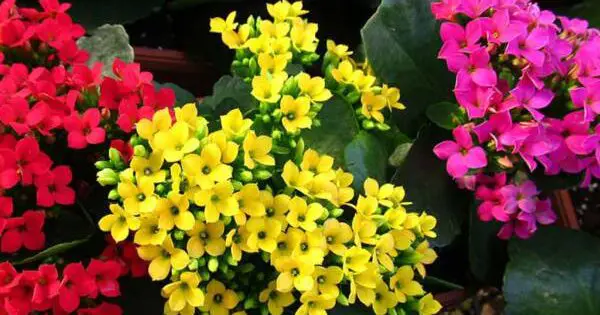The beauty of Kalanchoe (Kalanchoe blossfeldania) is known to flower lovers and horticulturists. Moreover, this plant is very often used to give stamp to a floral composition, with its bright and sparkling colors. This Kalanchoe is a succulent plant, native to the island of Madagascar, which is covered with flowers with single or double layers of petals.
This plant is cultivated in inside, the maintenance is relatively easy but some advices of watering or size will allow you all the same to improve the bloom.
Contents
The kalanchoe, indoor or outdoor plant?
Native to Madagascar, the kalanchoe, which is pronounced kalankoe, is a very beautiful fat plant, which is cultivated indoors.
Of culture and relatively easy maintenance, it poses almost no difficulty.
If it fears mainly the excess of water, it also likes to have a lot of light, but especially no direct scorching sun.
You will install it as well in a pot as in a planter box, but be careful not to leave them within reach of children or animals because their leaves are toxic if they ingest them.
Kalanchoe planting
Planting or repotting kalanchoe is an important step because it conditions the good growth and flowering of the plant.
Planting and repotting
This plant adapts itself to the soft climates and will be thus preferably cultivated in inside if you fear the frosts.
- You will be able to repot your kalanchoe right after purchase if you bought it outside the flowering period.
- Then, an annual repotting in the fall or after flowering will help to encourage the appearance of new flowers at the end of winter.
Bouturer le kalanchoé
Multiplication by cuttings in the fall. The cutting of kalanchoe is very simple.
- Remove the ends of the stems for 4 inches.
- Keep them dry for 24 hours
- Then soak it in cuttings hormone.
- Plant it in soil for sowing and cutting.
- Keep your cuttings in a bright place and heated to about 68°F.
Ideal soil and exposure for potted kalanchoe cultivation
Kalanchoe is easy to grow, but some precautions should be taken. To optimize the flowering, Kalanchoe grows very well in cool soil and in a bright environment without direct sunlight at a temperature of 50 to 59°F in winter and 80°F maximum in summer.
When to repot the kalanchoe?
To repot at least every two years in a very porous mixture type plants for planter box lightened by a ration of coarse sand. Incorporate a little organic fertilizer.
How to water the kalanchoe?
Watering the kalanchoe is important because it is a fat plant with specific needs. Follow our advice.
In all cases, it is important to wait until the soil is very dry before watering but also to give preference to a good watering rather than a multitude of small waterings.
Water every ten to fifteen days in winter and every three to four days from spring to fall. Even if you water less in winter, the soil should not dry out completely (crumpled foliage).
ATTENTION: The leaves of succulent plants are loaded with water. If they sag, they need to be watered.
Fertilization and fertilization
Parsimonious contributions, every 3 to 4 waterings only with a fertilizer for green or flowering plants according to the type cultivated.
How to multiply the kalanchoe?
It is easy by cutting leafy stems or leaves. Operate during the growing period. Remove a short stem (remove leaves from the base) or a leaf by pulling or cutting a portion of the stem with an eye.
Let these cuttings dry in the open air for two to three days before placing them in a pot or terrine in a very sandy substrate, in the air and with background heat (50 to 71°F), if possible. Fast rooting.
Some species multiply naturally by dropping aerial bulbils growing on the edge of the leaves.
Diseases and pests of Kalanchoes
At the time of purchase, examine your flowers carefully. They must still be in the beginning of coloration and in the form of buds. The presence of faded flowers indicates that it has already bloomed once and that its flowering cycle is coming to an end.
Another criterion of purchase, the leaves must be green and firm without the slightest trace of disease such as brown patches or white felting on the leaves which would then reveal the presence of a fungus. Scale insects and aphids are sometimes present. Scale insects and aphids are sometimes involved. Soapy water for the latter and alcohol swabs for the former will get the better of them.
Beware of various types of rot, avoid watering on the foliage.
A piece of advice: never use a polishing spray! This product burns the foliage.
Summary
The kalanchoe is a plant of short days. This means that it blooms naturally without artifice in autumn and until the end of winter.
Kalanchoes in bloom outside of this period have been placed in complete darkness for more than 12 hours each day to allow them to release flowering buds. Then the flowering takes place normally.








